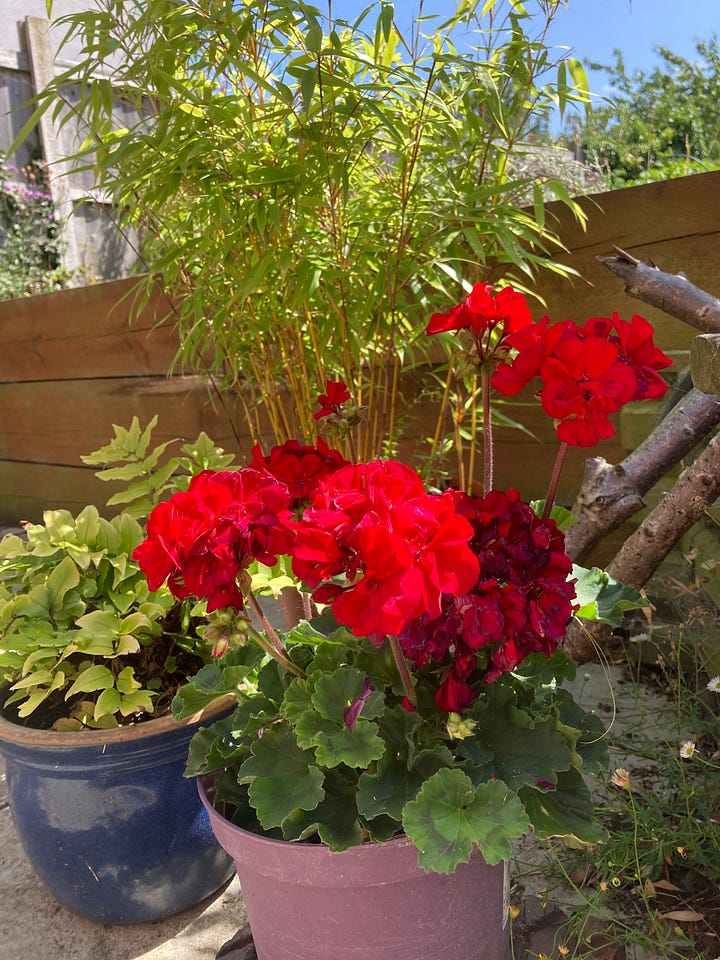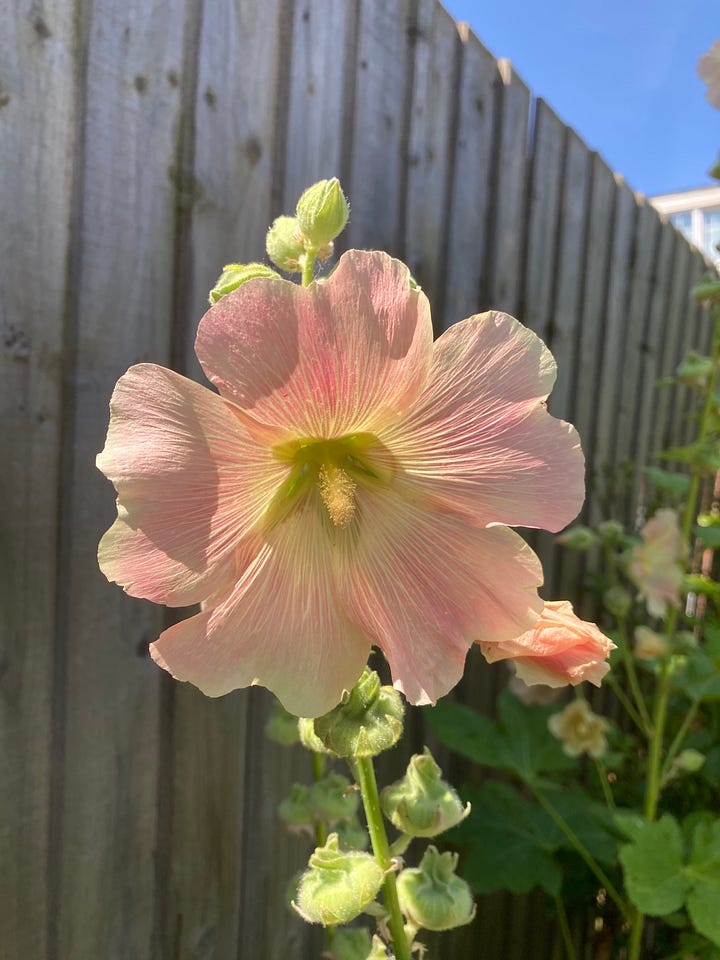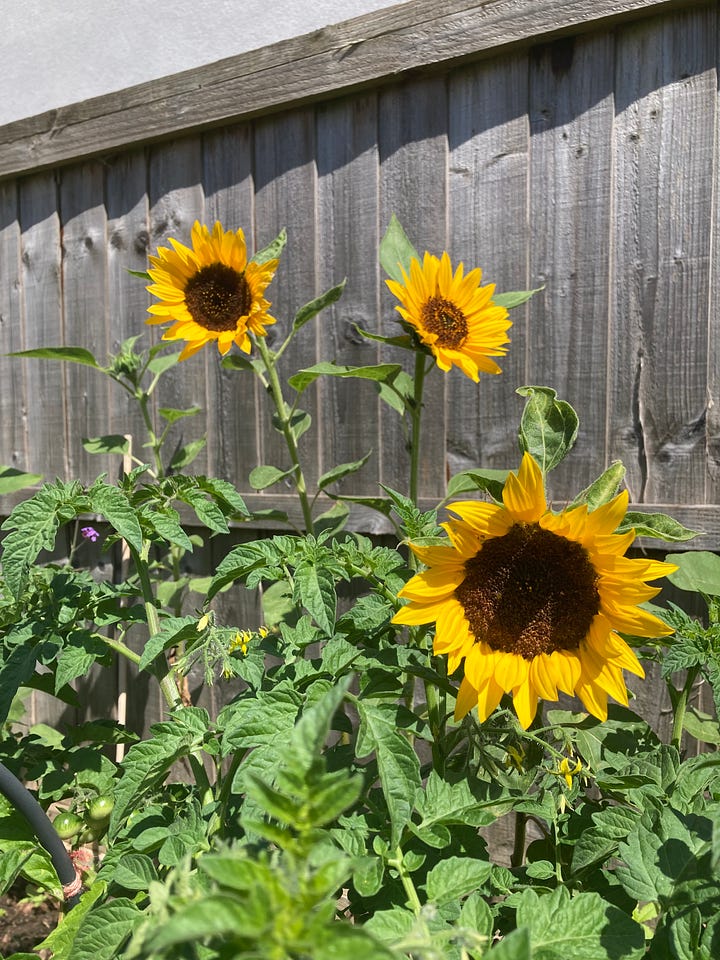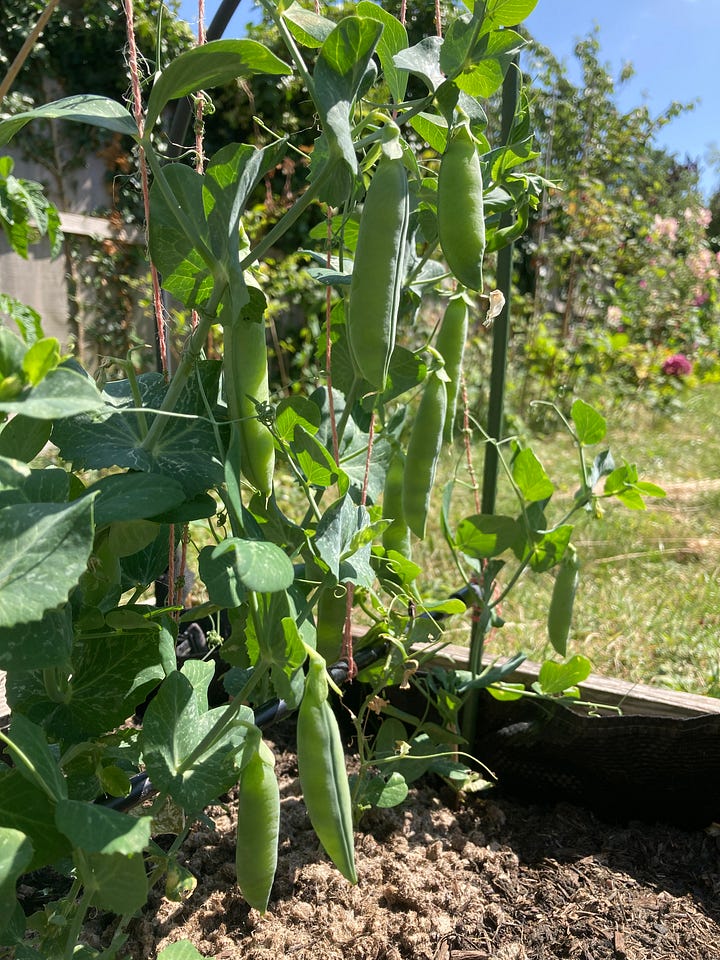I recently mused about my relationship with my garden and growing plants. In that Letter, I mentioned that I had not yet read Why Women Grow by Alice Vincent (find her substack savour here). Meanwhile, I borrowed the book from the local library. And I really enjoyed it! It complemented and expanded my own thoughts in wonderful ways.
Interwoven with Vincent’s inspiring and thought-provoking meetings with other women who garden are sections that let us in on her ambivalent feelings around getting married and motherhood. I think I had so far taken it for granted that growing and womanhood are somehow linked, but hadn’t unraveled what is metaphorical, what is stereotyping and what is lived experience. And it isn’t just growing and womanhood, there seems to be a triangular relationship between being female, growing things, and creativity.
Having devoted much thought recently to marriage and what it means for my life and for my creativity, I have been delighted to read about the relationship/marriage stories of women artists on Deborah Vass’ substack Still Sketching. For example this article about artist Mary Fedden, or this about Jean Cooke (interestingly, a garden features in many women artists’ biography!). I could mention other stories which I’ve recently come across, not least on Kate Jones’ great substack A Narrative of Their Own. It is quite sobering to read that so many women experience a stereotypical limiting of their creativity by marriage and motherhood, while I have been inspired by accounts of others who find emotional and creative stability with their partners. In many cases, of course, the reality is not an either/or, but a complex, frustrating and beautiful mix.


On the first few pages (p. 4-6), Vincent introduces a woman born in 1700 who was a polymath, writer, painter and gardener named Mary Delany. I loved learning about this fascinating woman, not least because it happens to be the name of the rose we bought recently to mark our 20th wedding anniversary!
I felt so seen where Vincent describes how she and her partner enjoy a balanced relationship (though I do wonder what that means exactly) but she still comes up against ‘compromise and strange, tacit agreements’, finds herself ‘taking on “women’s work”; those silent, stealthy actions of domesticity.’ (p. 235) Not for the first time do I wonder why this happens – why it has got to be the women in a relationship who remember appointments, commitments and birthdays, who plan the parties and buy the cards. I love how she describes the submerged feelings of anger and resentment:
‘In recent years I have felt my rage more keenly. Anger at the quiet injustices of existing as a woman, of earning less, of having less time to be visible, of being quietly underestimated most of the time. It simmers steadily. Sometimes when I am tired, or fed up of being asked questions, or frustrated at feeling so stretched between all the different things it feels we must be, this rage grows loud and powerful. I lose my temper, seemingly over something small. In reality, it is an iceberg: so much is hidden below the surface.’ (p. 235/6). I have very little to add to this, it is so exactly my own experience. But I equally know that the rage as such doesn’t change anything. It doesn’t melt the iceberg. It doesn’t bridge the gap, if anything, it makes the chasm bigger. My solution? I haven’t got one. It’s a practice. Practice taking up space at home. Practice communicating your needs. Make a plan for all those invisible domestic tasks to make them visible, reduce one-sided mental load, and make both partners accountable for keeping track of them (and actually doing them).
This requires practice, and awareness. Vincent writes, ‘Sometimes in the house I am still too busy trying to fit myself into a mould of womanhood I don’t recognise – the accomplished cook, the proud homemaker – but in the garden I can be and do as my body tells me, as my mind suggests, wrist-deep in soil.’ (p. 250). Some years ago, my husband said, ‘we both lack the housewife gene’. While he smiles and moves on, I push myself harder. The accomplished cook, the proud homemaker. Sometimes in the garden, we fall into gendered roles that neither of us believe in. He uses the heavy machinery (aka the lawnmower), he does the digging. I sow seeds, pull weeds, harvest peas.
Practice taking up space at home. Practice communicating your needs. Make a plan for all those invisible domestic tasks to make them visible.
Both gardening and creativity have become so inevitably, if metaphorically, linked with motherhood more specifically. Sometimes, it is in juxtaposition, the assumption being that (some) women garden or seek creative outlets in the place of having a child, whether that is by choice or not. The ability to have, or even the need for, both is not so often discussed. ‘Growing things’ is seen as an extension of women’s ‘maternal’ characteristics (or feelings, or instincts. Anybody else find this perplexing?!). Vincent rightly questions whether this is just, and the whole picture. She even asks, ‘if the garden was my space to shape, a place where I could be on my own terms, what might it mean to bring a child in?’ (p. 10). I never asked myself that question, neither before or after I had children. The children belonged in and to the garden. And yet I do frequently ‘escape’ to the garden to be alone, in my own space. I don’t feel particularly inspired to involve my children in my erratic bursts of gardening activity. But to potter about in the garden while children are playing around me is lovely. As is having the cat in the tall grass nearby.
Vincent claims that this kind of creating a space for ourselves is ‘one of the most quietly feminist acts there is’ (p. 189). But maybe this applies not only to women, not only to gardening mothers. I know that my father also disappeared into the jungle of our back garden to be alone, to shape his own space, his own dreams. As a child, I tried to form a connection with him by being interested in gardening, interested in his space, interested in what he was interested in. And I felt deeply hurt when he only grudgingly assented to help me sow flowers and a few vegetables in a patch I claimed as my own, and pained when he’d lose patience and sent me away with an angry bark. I understand him better now.
‘How much nurturing, I wondered, were women supposed to be capable of?’ (p. 13) asks Alice Vincent. I believe it is high time that we ask ourselves this. Does my father not nurture his garden? His raspberry canes and bean stalks? But I doubt that any literature would describe a man’s gardening through a maternal lens, nor would he think about it in this way. While I have felt guilty about keeping the garden my own space, I doubt he felt anything like that when he sent me away.
As women, we are supposed to be nurturing by virtue of being female. But what about those of us who do not feel they are able to connect with this (human) quality? I resented breastfeeding (years later, I understand the reasons better), despite believing it to be the best thing for my babies, despite (or because of) having a painful overabundance of milk. It wasn’t where I bonded with my children. It is a miracle that the mother’s body is capable of producing everything a child needs to grow and develop in their first months of life. My body nurtured my children whether I wanted to or not. But I refused to nurture myself in return.
In extension of that I discovered not so long ago that I don’t really enjoy cooking. Of course, there are other ways of nurturing that go beyond food, just as gardening isn’t only about sowing seeds, watering and fertilising.


At Charleston, Vincent tries to trace Vanessa Bell’s influence and presence in the gardens. While these seem linked with the perception that Bell was ‘some kind of domestic earth mother’, it is clear that the reality was not as archetypal: ‘as it is for many women, Bell’s maternity was complicated’ (p. 215). Bell’s daughter later claimed that the mothering she received was problematic, to say the least.
We are supposed to nurture while not being taught what it means to nurture ourselves. Unsurprisingly, gardening becomes a place that offers nurturing, indeed, mothering, to many women, as Vincent found:
‘If Marchelle grows because of something so alive and visceral – of a need to be mothered – what other connections are waiting to be unearthed?’ (p. 22)
I believe that this could be true for both women and men. But the more I think about it, this would require a different relationship with our outdoor spaces. One that is not only reciprocal, but where the earth (our garden) is in the lead. Where we listen more than we ‘talk’. Where we allow rather than do.
It is easy to romanticise gardening. When we see ourselves wrist-deep in warm, fertile soil, gathering armfuls of flowers in all colours of the rainbow, or harvesting crates of juicy apples, we might believe that this is the very image of wholeness. As Vincent states:
‘In recent years ‘nature’ more broadly has been positioned as a healer, but I think this oversimplifies a complex relationship and one more innately grounded in us than we understand.’ (p. 55) She continues: ‘But if we only expect nature, or our gardens, to heal us – to make us feel better, to provide a balm or solace from our daily problems – how reciprocal can our relationship with the earth really be, and how thoroughly are we understanding the problems it is facing?’ (ibid.)
The reality, like our human relationships, including that with our mothers, is probably a lot more complicated. The soil can be experienced as nurturing and accepting, forgiving and non-judgemental. Some women Vincent talked to felt strongly that there is no right or wrong in the garden, its ‘ambiguity’ releasing them from expectations (p. 104). I am not sure I agree about the absence of right and wrong, but experiencing a green space across the season is definitely ambiguous. The soil can equally be merciless and self-contained, unyielding and punishing. And we must not overlook what we have done to the earth as a species: ‘In looking blindly to gardens as spaces only to heal ourselves, we ignore the suffering we’ve inflicted on the earth in taking from it so relentlessly for centuries – and the opportunity we have to tread more gently.’ (p. 55/56)
Vincent also considers relationship between ‘creating things and raising children’ (p. 255) throughout the book, and it is a subject that comes up again and again in her conversations with other women. When she talks to an older photographer, she learns that ‘A chunk of my creative life […] will go on hold if I have children, and if that happens, it will be fine.’ (p. 255) I wonder if now that she has a child she still feels ‘fine’ about that. And something in me still questions whether it has to be this way, whether we do have to put a chunk of our creative life and of ourselves on hold. I am not (just) calling for more, and more flexible, affordable, childcare. I know we still have a long way to go even in that respect and we cannot ignore or fully do away with certain biological factors. But I wonder if we are thinking about it in the wrong way sometimes, by persisting in viewing the two in binary, and irreconcilable, opposition.
“creating things and raising children”:
I wonder if we are thinking about it in the wrong way sometimes, by persisting in thinking about the two in binary, and irreconcilable, opposition
Across the book, there are so many different and nuanced portraits of people and their relationship with outdoor spaces. One of the women she meets, named Fernanda, says: ‘Your garden, for the most part, is a representation of what you want closest to you.’ (p. 201). As I am writing this, I am looking out into my garden. I see the birch’s drooping branches sway in the wind, and hear the beech leaves rustle. There is the shed with its painted door, and the raised bed with rambling runner beans, pumpkin and courgette plants with large, yellow blossoms. Their yellow is echoed further along the fence by the sunflowers dancing behind the tomatoes. Towering hollyhocks serve as stalks for perennial sweet peas. Bright red garden geraniums flower in pots on the patio. Is it just these I want closest, at face value, or do they stand for something else? If so, what? Do I want colour in my life? Bold statements? Or do I want these plants close because they reflect something that is either part of me, or something I crave?
Fernanda also remarks: ‘I find it hard to talk about soil without talking about an underlying question of belonging… a big emotional and political question…’ (p. 203/204). Emotional, because we may not find belonging elsewhere, and political, because there are big inequalities in who owns land and who doesn’t, who gets time to grow and who doesn’t.
Many people, including Fernanda, find that gardening helps to ‘metaphorically and literally set down roots’ (p. 205). Another woman (originally from Trinidad) said: ‘I thought if I’m going to be living in this country, if I’m going to feel like I belong here, actually I need to do something about that. And the best way I’m going to feel like I belong here is to have a relationship with the land’ (p. 22) – as a fellow expatriate, this resonates deeply. Since leaving my childhood home (and garden) I have experienced this many times. I kept herbs and flowers in a window box in the first flat I shared with my partner. There was nowhere to actually have a window box (we lived under the roof of a 16th cent. timber framed listed building), but I lowered the boxes down onto the roof away from the street. It stayed put thanks to a grille supposed to keep snow on the roof in winter. In Sussex, I spent an afternoon in early spring freeing a rose from overgrowth in our tiny backyard and discovering a host of daffodil shoots. In that garden, the soil was only an inch deep, barely covering the solid chalk underneath. In every place I have attempted to grow whatever tentative roots I could, learning about the nature of the soil and the tendencies of the weather (our Cheshire garden was a perpetual bog due to the incessant rains that side of the Pennine range. Even the grass drowned). In the years when I travelled a lot, I noticed most immediately how an hour or so of watering, weeding and getting my hands dirty would ground and anchor me. It is a coming home to myself.
And yet I wake up at night and often I don’t know where I am. I don’t know what landscape surrounds the house in the dim light of these midsummer nights. Often, I half believe that if I looked out, I’d see the familiar outline of the trees and bushes of my parents’ garden against the night sky. Perhaps it is because I have severed the connection to my physical roots as represented in ‘place’ that these liminal times between waking and sleeping make me feel so untethered.
Like Camilla in Alice Vincent’s book, I was never asked ‘Where would you like to live…?’ (p. 244), or if I was asked, my answer had no influence on the reality as we moved where my husband’s job (and the children’s needs) have taken us. And yet I strongly believe the potential for connection lies right under our feet. Maybe we all need more of what Robin Wall Kimmerer calls ‘indigenousness to place’ in Braiding Sweetgrass.
To be continued!
P.S. Thank you for being here! If you have read Alice Vincent’s book (or another that resonates), let me know in the comments!
And if you enjoyed this post, consider clicking the heart-shaped button to let me know. Liking, restacking and sharing with a friend help others find my writing.
Go well, my friends!




Thank you very much for the mention, it is so kind of you to share my posts. I have yet to read Vincent's book, though I have enjoyed her other writing very much, and clearly should read this too. Another that leaves me much to ponder on about the relationship between gardening and creativity. My garden has always been a place of solace and restoration, a place that is away from the house and domestic responsibilities - though it sometimes a hard fought place to be!